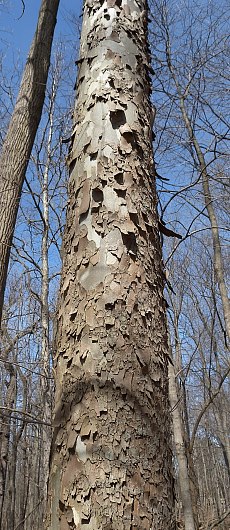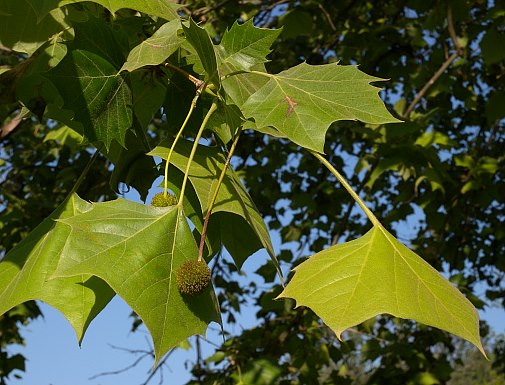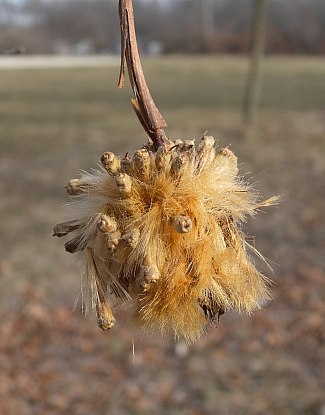Description:
This deciduous tree is 60-140' tall and 3-8' across at the base of the
trunk. In open areas, the crown is ovoid and irregular with crooked
branches. In forested areas, the crown is smaller and more narrow.
There is usually a single central trunk that is straight. On a mature
tree, the bark of the lower trunk is loose, scaly, and brown. In
contrast, the bark of the upper trunk and
branches exfoliates,
revealing smooth patches of inner bark that are light gray, light
brown, and white. Developing twigs are light green and pubescent; they
become glabrous, woody, and orange-brown or light brown with age. The
blades of alternate leaves are 4-10" long and similarly across; they
have 3-5 palmate lobes and margins that are coarsely dentate. The lobes
have pointed tips and broad bases; the concave sinuses between the
lobes are wide and shallow. The upper blade surface is light to medium
green and glabrous, while the lower surface is more pale and variably
pubescent. Young leaves have pubescent lower surfaces, while older
leaves are either glabrous or their pubescence is restricted to the
major veins. The petioles are up to 6" long, light green, and glabrous
or short-pubescent. The base of each petiole is swollen and encircles
the bud. Near the base of each petiole, there is a large leafy stipule
that is coarsely toothed; it surrounds the twig. American Sycamore is
monoecious, producing separate male (staminate) and female (pistillate)
florets on the same tree while its leaves are developing. The male
florets are arranged together into dense green flowerheads that are
globoid in shape, and similarly for the female florets. The blooming
period occurs during the spring; the florets are cross-pollinated by
the wind. Afterwards, the male flowerheads become detached from the
tree and wither away, while the female flowerheads are replaced by
light brown seedheads about ¾-1½" across that hang from peduncles up to
6" long. There is usually one seedhead per peduncle; two seedheads per
peduncle are uncommon. These seedheads persist on the tree through the
winter until they break apart no later than late spring of the
following year. Individual seeds are embedded in achenes that are
narrowly oblanceoloid, winged, and up to ½" long. At the base of each
achene, there is a tuft of long tan hairs. The achenes are distributed
by wind and water. The woody root system is widely spreading and
branched.
upper trunk and
branches exfoliates,
revealing smooth patches of inner bark that are light gray, light
brown, and white. Developing twigs are light green and pubescent; they
become glabrous, woody, and orange-brown or light brown with age. The
blades of alternate leaves are 4-10" long and similarly across; they
have 3-5 palmate lobes and margins that are coarsely dentate. The lobes
have pointed tips and broad bases; the concave sinuses between the
lobes are wide and shallow. The upper blade surface is light to medium
green and glabrous, while the lower surface is more pale and variably
pubescent. Young leaves have pubescent lower surfaces, while older
leaves are either glabrous or their pubescence is restricted to the
major veins. The petioles are up to 6" long, light green, and glabrous
or short-pubescent. The base of each petiole is swollen and encircles
the bud. Near the base of each petiole, there is a large leafy stipule
that is coarsely toothed; it surrounds the twig. American Sycamore is
monoecious, producing separate male (staminate) and female (pistillate)
florets on the same tree while its leaves are developing. The male
florets are arranged together into dense green flowerheads that are
globoid in shape, and similarly for the female florets. The blooming
period occurs during the spring; the florets are cross-pollinated by
the wind. Afterwards, the male flowerheads become detached from the
tree and wither away, while the female flowerheads are replaced by
light brown seedheads about ¾-1½" across that hang from peduncles up to
6" long. There is usually one seedhead per peduncle; two seedheads per
peduncle are uncommon. These seedheads persist on the tree through the
winter until they break apart no later than late spring of the
following year. Individual seeds are embedded in achenes that are
narrowly oblanceoloid, winged, and up to ½" long. At the base of each
achene, there is a tuft of long tan hairs. The achenes are distributed
by wind and water. The woody root system is widely spreading and
branched.
Cultivation:
The preference is full or partial sun and moist to mesic conditions.
American Sycamore adapts to a wide range of soil types, including those
that contain loam, clay, silt, sand, or gravel. It grows fairly rapidly
and can live at least 250 years. After a cool rainy period during the
spring or early summer, the leaves sometimes succumb to anthracnose.
When this happens, they are replaced with new leaves during the warmer
weather of summer and usually the tree is not significantly damaged.
Range &
Habitat:
American Sycamore is a common native tree that is found in all counties
of Illinois (see Distribution
Map). Habitats consists of bottomland woodlands, mesic
woodlands, wooded banks of streams and rivers, higher ground of swamps,
shaded seeps, and abandoned fields. Less often, this tree is found in
upland woodlands. American Sycamore usually occurs as an occasional
individual tree or in small groups. It is often found with other
bottomland deciduous trees, including Red Maple, Silver Maple, Eastern
Cottonwood, American Elm, and Black Willow, in areas that are prone to
occasional flooding during the spring. Because of its relatively thin
bark, fire tolerance is poor. Because of its attractive multi-colored
bark, American Sycamore is often used in city parks and yards as a
landscape tree.

Faunal
Associations:
Various insects are known to feed on the foliage, wood, and other parts
of American Sycamore. These species the caterpillars of Halisidota
harrisii (Sycamore Tussock Moth) and Misogada
unicolor (Drab Prominent), the wood-boring larvae of Chalcophorella
campestris (Sycamore Heart Borer) and Goes
pulverulentes (Living Beech Borer), the plant bugs Plagiognathus
albatus and Reuteria platani, the seed
bug Belonochilus numenius, and Corythucha
ciliata (Sycamore Lace Bug). American Sycamore is the
preferred host of several leafhoppers, specifically: Eratoneura
arta, Eratoneura bella, Eratoneura
ingrata, Eratoneura lawsoni, Eratoneura
morgani, Eratoneura torella, and Eratoneura
usitata (syn. Erythroneura arta, Erythroneura
bella, etc.). The seeds are eaten by some songbirds during
the winter, particularly the Purple Finch, and to a lesser extent the
Eastern Goldfinch, Black-Capped Chickadee, Carolina Chickadee, and
Slate-Colored Junco. The leaves and twigs are eaten by White-Tailed
Deer only to a limited extent, while the wood is occasionally consumed
by the Beaver. As this tree becomes older, its cavities are used as
nesting habitat by such birds as the Barred Owl, Screech Owl, Wood
Duck, Chimney Swift, and Great Crested Flycatcher. Sometimes, a cavity
at the base of a tree becomes large enough to accommodate the Black
Bear, while smaller cavities are used as dens by tree squirrels, bats,
and other mammals.
Photographic Location:
The photographs of the leaves and disintegrating seedhead were taken at
Chief Shemauger Park in Urbana, Illinois, while the photograph of the
tree trunk was taken at Busey Woods in the same city.

Comments: This is the only species in the Plane Tree family that is native to Illinois. Fossil records reveal that there were similar trees toward the end of the Dinosaur age about 70-80 million years ago, and so the lineage of this tree is very old. Because of its multicolored bark, American Sycamore is easily distinguished from most other trees in Illinois. An exception is the London Plane Tree (Platanus × acerifolia), which uses American Sycamore as one of its parents. The London Plane Tree also has multicolored bark and it is often planted along streets in cities because of its tolerance of urban pollution. This latter species differs from the American Sycamore as follows: 1) The lobes of its leaves are more long and narrow, while the sinuses of its leaves are more deep and narrow, 2) it usually produces 2 seedheads or more per peduncle, rather than a single seedhead per peduncle, 3) its leaves tend to have fewer teeth along their margins, and 4) its bark is more likely to be multicolored and smooth all the way to the bottom of the trunk. This last characteristic is probably the result of nurseries selecting hybrid trees with showier bark.